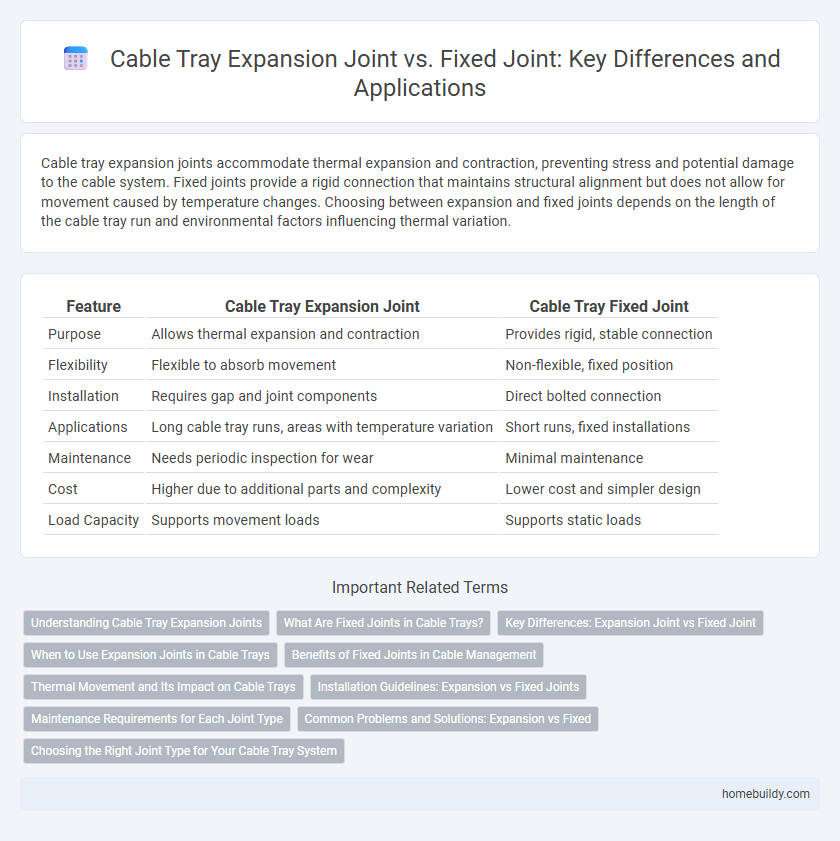Cable tray expansion joints accommodate thermal expansion and contraction, preventing stress and potential damage to the cable system. Fixed joints provide a rigid connection that maintains structural alignment but does not allow for movement caused by temperature changes. Choosing between expansion and fixed joints depends on the length of the cable tray run and environmental factors influencing thermal variation.
Table of Comparison
| Feature | Cable Tray Expansion Joint | Cable Tray Fixed Joint |
|---|---|---|
| Purpose | Allows thermal expansion and contraction | Provides rigid, stable connection |
| Flexibility | Flexible to absorb movement | Non-flexible, fixed position |
| Installation | Requires gap and joint components | Direct bolted connection |
| Applications | Long cable tray runs, areas with temperature variation | Short runs, fixed installations |
| Maintenance | Needs periodic inspection for wear | Minimal maintenance |
| Cost | Higher due to additional parts and complexity | Lower cost and simpler design |
| Load Capacity | Supports movement loads | Supports static loads |
Understanding Cable Tray Expansion Joints
Cable tray expansion joints accommodate thermal expansion and contraction, preventing structural damage and maintaining cable integrity in long cable runs. These joints allow controlled movement within the tray system, reducing stress on cables and supporting infrastructure compared to fixed joints that restrict movement and risk deformation. Proper installation of expansion joints ensures system reliability and extends the lifespan of cable management setups in industrial and commercial environments.
What Are Fixed Joints in Cable Trays?
Fixed joints in cable trays are connection points designed to provide rigid support and maintain the structural integrity of the tray system. They prevent movement and ensure cable stability by securely fastening sections together, ideal for areas where thermal expansion or contraction is minimal. Unlike expansion joints, fixed joints do not accommodate movement, making them crucial for maintaining alignment and load distribution in cable management systems.
Key Differences: Expansion Joint vs Fixed Joint
Cable tray expansion joints accommodate thermal expansion and contraction, preventing structural stress and maintaining system integrity, while fixed joints provide rigid connections that secure the tray in a stationary position. Expansion joints feature flexible components or sliding mechanisms enabling movement, contrasting with fixed joints that lack such flexibility and are bolted or welded firmly. The key difference lies in their functional role: expansion joints manage dynamic forces and length variations, whereas fixed joints ensure stability and alignment of the cable tray installation.
When to Use Expansion Joints in Cable Trays
Expansion joints in cable trays are essential when accommodating thermal expansion and contraction caused by temperature fluctuations, typically in long cable tray runs exceeding 10 meters. They prevent structural damage and maintain system integrity by absorbing movements and minimizing stress on the tray and cables. Fixed joints are suitable for shorter runs or environments with minimal temperature variation, where movement is negligible.
Benefits of Fixed Joints in Cable Management
Fixed joints in cable trays provide superior stability and load-bearing capacity, essential for maintaining cable alignment and preventing sagging over long distances. These joints ensure a rigid connection that minimizes vibration and mechanical stress, enhancing the durability of cable installations in industrial and commercial settings. The reliability of fixed joints reduces maintenance requirements and supports consistent cable performance in critical electrical systems.
Thermal Movement and Its Impact on Cable Trays
Cable tray expansion joints accommodate thermal movement by allowing longitudinal expansion and contraction without stressing the cable system, while fixed joints maintain rigid connections, restricting movement and risking structural damage. Thermal fluctuations cause metal trays to expand or contract, potentially leading to deformation or joint failure if not managed correctly through expansion joints. Properly designed expansion joints ensure cable integrity, reduce stress on supports, and prolong the lifespan of cable tray installations in environments with significant temperature variations.
Installation Guidelines: Expansion vs Fixed Joints
Installation guidelines for cable tray expansion joints emphasize allowing for thermal movement, requiring precise alignment and secure fastening to prevent damage. Fixed joints demand rigid connection points with strong support to maintain structural stability and prevent joint separation. Proper installation of both joint types ensures the longevity and integrity of cable management systems in varying environmental conditions.
Maintenance Requirements for Each Joint Type
Cable tray expansion joints require regular inspection and lubrication to accommodate thermal expansion and contraction, preventing misalignment and ensuring smooth operation. Fixed joints demand less frequent maintenance but need periodic checks to verify structural integrity and secure fastenings due to their rigid connection. Proper maintenance of both joint types extends the lifespan of the cable tray system and minimizes downtime caused by joint failures.
Common Problems and Solutions: Expansion vs Fixed
Cable tray expansion joints often face issues such as misalignment, excessive vibration, and thermal movement stress, which can cause structural damage or cable strain. Fixed joints typically encounter challenges with limited flexibility, leading to potential cable damage during thermal expansion or contraction. Solutions include installing expansion joints with adequate gap allowances and flexible connectors to accommodate movement, while fixed joints require careful installation and periodic inspection to prevent stress-related failures.
Choosing the Right Joint Type for Your Cable Tray System
Selecting the right joint type for your cable tray system depends on factors such as thermal expansion, system length, and environmental conditions. Expansion joints accommodate changes in length caused by temperature fluctuations, preventing structural stress and damage, while fixed joints provide rigid connections for shorter, stable sections. Proper joint choice ensures system integrity, reduces maintenance costs, and enhances overall cable protection in industrial installations.
Cable tray expansion joint vs fixed joint Infographic

 homebuildy.com
homebuildy.com